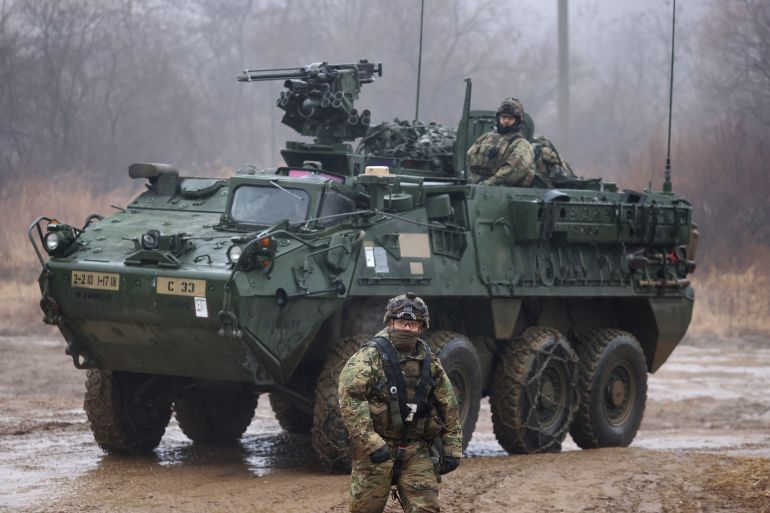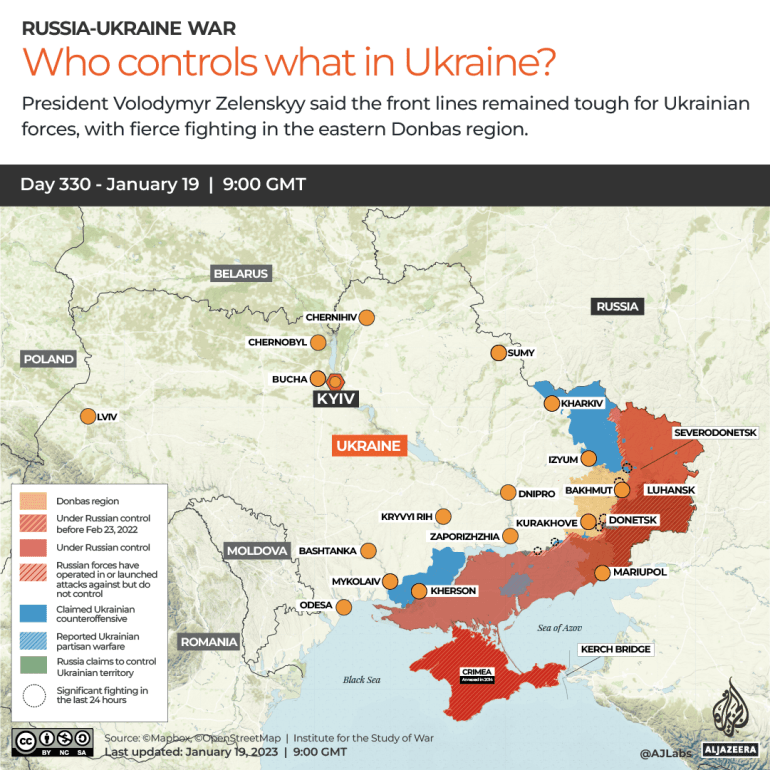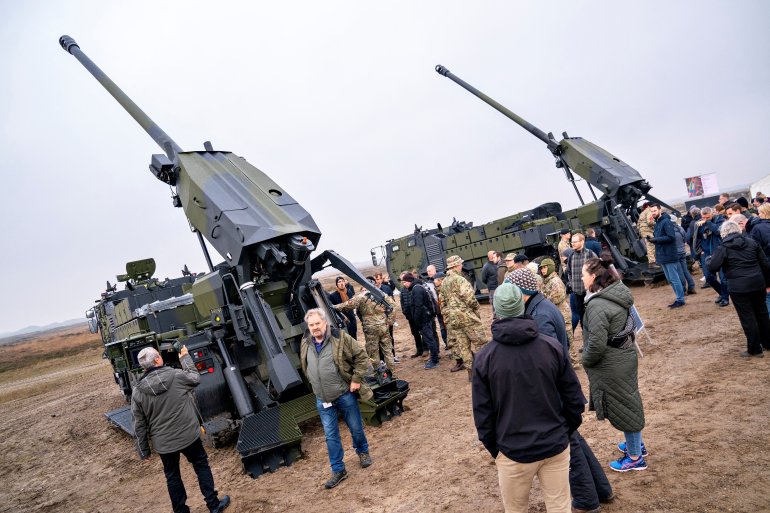US, European allies pledge more military firepower for Ukraine
Heavy weaponry is promised to support Kyiv’s ‘heroic resistance’ against Russia, despite Moscow’s threats.

The United States and some of its European allies have announced significant new arms donations to Ukraine, including armoured vehicles and heavy weaponry, ahead of a crucial meeting on bolstering the country’s defences nearly a year after Russia invaded.
The US said its package of military support – which includes armoured personnel carriers, air defence systems and tens of thousands of rockets and artillery rounds – was worth some $2.5bn. There will be 59 Bradley Fighting Vehicles and 90 Stryker Armoured Personnel Carriers, the US Defense Department said in a statement on Thursday.
Keep reading
list of 4 items‘A whole new level’ of war if NATO arms Ukraine, Russia warns
Why has Germany prevented supply of Leopard 2 tanks to Ukraine?
Leaders of Chechnya, Wagner blast Russian army beard ban
Secretary of State Antony Blinken said it was a “significant new security assistance package to help Ukraine continue to defend itself against Russia’s brutal war.” The latest package brings US military assistance for Ukraine to some $27.4bn, he added.
Earlier, the United Kingdom, in a joint statement with defence ministers and representatives of nine European countries, said it would send 600 Brimstone missiles to Kyiv, while Denmark promised 19 French-made Caesar howitzers, and Sweden its Archer artillery system, a modern mobile howitzer Ukraine has been requesting for months.
“We recognise that equipping Ukraine to push Russia out of its territory is as important as equipping them to defend what they already have,” the statement said.
“Together we will continue supporting Ukraine to move from resisting to expelling Russian forces from Ukrainian soil. The new level of required combat power is only achieved by combinations of main battle tank squadrons, beneath air and missile defence, operating alongside divisional artillery groups, and further deep precision fires enabling targeting of Russian logistics and command nodes in occupied territory.”

The announcements came ahead of a meeting of defence and other officials from some 50 countries, including all 30 members of NATO, at the Ramstein Air Base in Germany to discuss support for Kyiv amid brutal battles in Ukraine’s east and Russia’s continued air attacks on its cities.
Looking ahead to the German talks, Ukrainian President Volodymyr Zelenskyy said late on Thursday that Kyiv expected “strong decisions” from the meeting.
“We are, in fact, now waiting for a decision from one European capital, which will activate the prepared chains of cooperation regarding tanks,” Zelenskyy said in a video address.
“We are preparing for the Ramstein meeting tomorrow. We are expecting strong decisions. We are expecting a powerful military aid package from the United States,” he added.
Kremlin warnings
Pressure on Germany to provide its modern Leopard 2 tanks is intensifying, with Chancellor Olaf Scholz’s government so far appearing reluctant to authorise their transfer for fear of provoking Moscow. Germany has veto power over any potential transfer.
The Kremlin warned on Thursday that sending heavy weapons capable of striking Russian territory would be construed as an escalation.
“Potentially, this is extremely dangerous,” Kremlin spokesperson Dmitry Peskov told reporters. “It will mean bringing the conflict to a whole new level which, of course, will not bode well from the point of view of global and pan-European security.”
Ukraine and Russia have both relied primarily on Soviet-era T-72 tanks, which have been destroyed in their hundreds during the war that began on February 24 last year when Russian President Vladimir Putin sent troops across the border in what he continues to call a “special military operation”.

Fearing the colder months will give Russian forces time to regroup and unleash a significant attack, Ukraine has stepped up calls on its allies to increase assistance.
During his trip to Washington, DC in December, Zelenskyy told the US Congress that supporting Ukraine was not charity but an investment in democracy.
Berlin on Thursday appeared to leave open the prospect of allowing allies to supply Ukraine with the requested tanks, saying the situation would “become clear in the next few hours or tomorrow morning”.
Lithuania’s defence minister, Arvydas Anusauskas, told the AFP news agency that “some countries will send” Leopard tanks to Ukraine, promising “more news tomorrow” at the talks.
Ukraine’s Western allies have been reluctant to transfer heavier weapons to avoid NATO appearing to confront Russia directly, but officials in Kyiv say tanks are crucial if Ukraine is to recapture land occupied by the Russians and defend itself from further attacks.
“From Washington to London, from Paris to Warsaw, you hear one thing: Ukraine needs tanks. Tanks are the key to ending the war properly. It is time to stop trembling before Putin and take the final step,” Zelenskyy adviser Mykhailo Podolyak said in a tweet.
Meanwhile, CIA Director William Burns travelled in secret to Kyiv to meet Zelenskyy, a US official told the Reuters news agency on Thursday, declining to say when the visit took place.
The Washington Post, which first reported Burns’s trip, said the CIA director was in Ukraine at the end of last week and briefed Zelenskyy on how the US sees Russia setting its military plans in the coming weeks and months.
Fighting continued to be most intense in the eastern industrial region known as the Donbas, Ukrainian military officials said on Thursday night.
The General Staff of the Ukrainian Armed Forces said Russian forces shelled the town of Bakhmut, Russia’s main focus in the Donetsk province, which combined with the Luhansk province form the Donbas region.
Soledar, about 20 km (12 miles) from Bakhmut, also came under fire. Russian forces say they control the town, which is renowned for its salt mines, while Ukraine says its military is still fighting there.
Nearby towns also were shelled by Russian forces – including Klishchiivka, just south of Bakhmut, the Ukrainian military said. Yevgeny Prigozhin, head of the Wagner Russian mercenary army, said his forces have taken control of Klishchiivka, a claim contested by Ukraine.